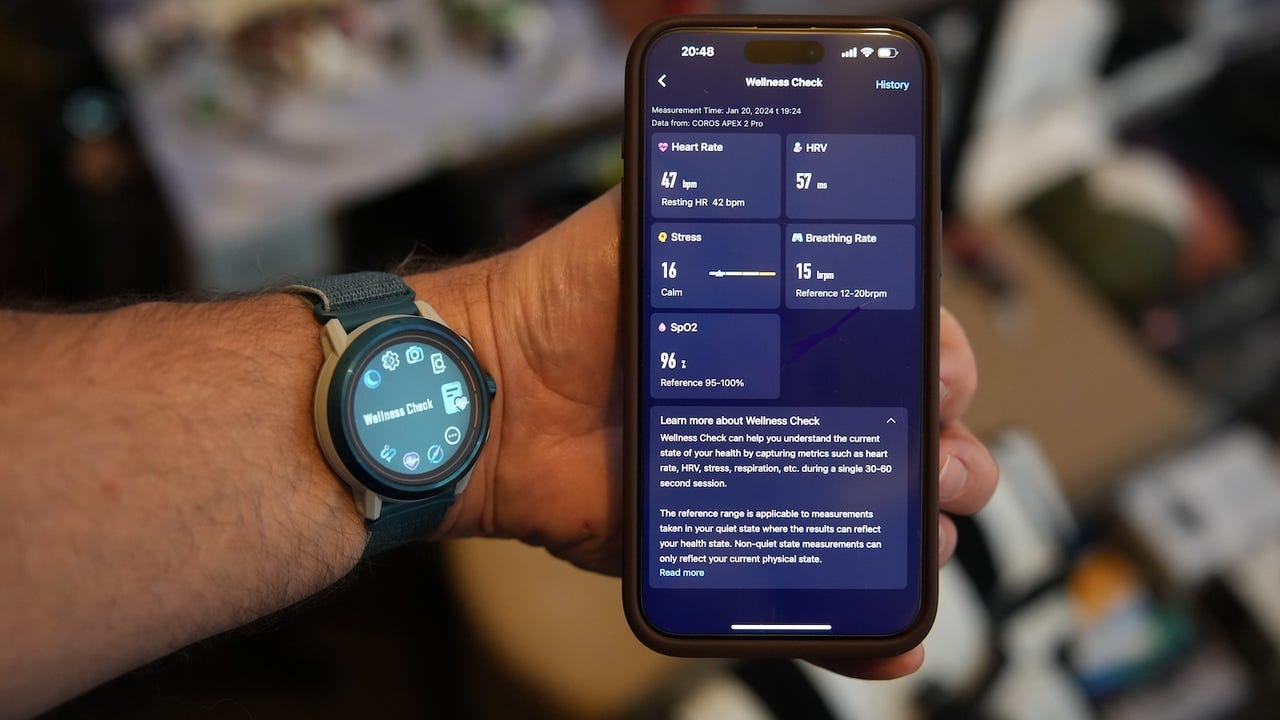
































Six years ago, I saw my first Coros watch, the original Pace, at a CES press event. Since then, I've tested just about every model released. At the beginning, the watches were compelling for their unmatched battery life and long-term software support, but I pretty much only wore a Coros watch during the activities that I wanted to track.
Also: This AI-enabled e-bike uses ChatGPT to give you a smarter ride
Coros has been releasing feature updates during the past couple of years that are focused on overall health and wellness. These updates make the watches more useful for 24/7 wear and data collection. Sleep tracking now provides details of your various sleep stages (there still is no overall sleep score though), walking is now an activity option, HRV is captured during sleep, and the free workout library continues to grow as people look for supplemental workouts to help with core exercises, such as running and biking.
The new February 2024 feature update will start rolling out on Feburary 1, and I've been testing it for a couple of weeks in beta form. Three primary features are included in this update, as I'll break down below, and they're slowly but surely convincing me to stick with a Corso watch daily.
The first new feature is a fitness test. Coros watches currently have a running fitness test that helps validate the race predictor feature on your watch. The newRunning Form Testrequires you to mount a Coros Pod or Pod 2 to the center back of your waist, start the test on the watch, and then follow the 10-minute guidance on your watch, which includes a five-minute warm-up period.
Once you complete the test, you can view the assessment details in the Coros smartphone application. The assessment will provide you with a score and criteria focused on skill, strength, and balance. Details include ground time, strike angle, stride ration, left/right foot balance, leg stiffness, and peak ground reaction force. The results might help you improve your form and the overall process is much cheaper than gait testing in a lab.
Also: RingConn takes on Oura with its impressive subscription-free smart ring
Stress is a metric that is being added in many devices, including the Oura ring. Given the impact that high stress has on your health and wellness, it's a very important metric to understand. Coros has addedDaily Stressto its watches, and the feature uses heart rate and heart rate variability as the primary data inputs.
Plots of your stress throughout the day can be viewed on your phone in the smartphone app and in the Daily Stress widget in the Coros device, which can be found by scrolling up from the main watch face. The range of your stress, as well as daily, weekly, and monthly averages, are provided. It's interesting to see how meetings, traffic, and other events that are not workouts can impact your stress levels. Awareness of your internal stress and your situation should help you better manage your stress.
Be aware that enabling the Daily Stress feature will have an impact on your battery life. Coros states that the Apex 2 Pro I am wearing will see battery life go from 30 days to 25 days. The new Pace 3 will go from 24 days to 17 days, and the flagship Vertix 2 from 60 days to 43 days. Given the long battery life of Coros watches, it's worth enabling the Daily Stress feature to better understand your body and improve your health.
Also: Coros Pace 3 review
The third new feature added in this update is theWellness Check. Coros watches capture an amazing amount of data and provide these details in the smartphone app and your workout results. You may want to look at key metrics on a regular basis to check trends or to see how your body is responding in certain situations.
The Wellness Check can be accessed from the toolbox by holding the back button and scrolling to the right option. The instructions show you that you need to touch the digital crown with a finger on your opposite hand and then wait as the watch captures your data in 30-60 seconds. After the check is completed, the Coros watch and application will show you your resting heart rate, heart rate variability, breathing rate, stress level, and blood oxygen level.
 Hot Tags :
Tech
Hot Tags :
Tech